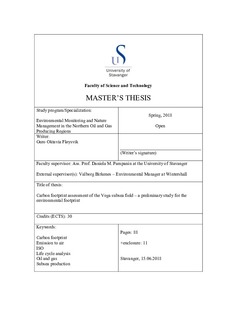| dc.contributor.advisor | Pampanin, Daniela M. | |
| dc.contributor.advisor | Birkenes, Valborg | |
| dc.contributor.author | Fløysvik, Guro Oktavia | |
| dc.date.accessioned | 2018-10-16T12:51:27Z | |
| dc.date.available | 2018-10-16T12:51:27Z | |
| dc.date.issued | 2018-06-15 | |
| dc.identifier.uri | http://hdl.handle.net/11250/2568268 | |
| dc.description | Master's thesis in Environmental technology | nb_NO |
| dc.description.abstract | Subsea tie-in fields on the Norwegian continental shelf (NCS) appear to have extremely low greenhouse gas intensity based on available environmental data, as emissions related to offshore oil and gas processing is reported from the host platform. The goal of this thesis was to quantify the environmental footprint of the subsea field Vega with respect of emission to air. The work was simplified by using carbon footprint as a single-issue method. A carbon footprint should, according to ISO 14067, be quantified by greenhouse gas (GHG) emissions and removals over the life cycle of a product. The methodological framework described by the international organization for standardization was adapted to this study by applying a bottom-up approach for data collection and inventory modelling. A case study was included to illustrate an example of how the inventory model can be used. Results: The carbon footprint (total GHG emissions) and GHG intensity of Vega were estimated as 0,290 million tons CO2-eq. and 0,411 kg CO2-eq./GJ respectively for 2010-2017. Discussion around the inventory results is focused on GHG intensity rather than total GHG emission (i.e. carbon footprint). This was to reflect the Norwegian Environmental Agency’s goal to both reduce greenhouse gas emission and increase production of hydrocarbons on the Norwegian continental shelf. Conclusion: Applying a life cycle inventory approach drastically changed the emission profile of Vega, compared to the current reporting practice. However, as this project represent the very early stage of implementing life cycle thinking in Wintershall, the principles of the life cycle inventory are more important than the inventory results itself. Further implementation of life cycle assessment within Wintershall should be based on the intended use and goals set by the company. | nb_NO |
| dc.language.iso | eng | nb_NO |
| dc.publisher | University of Stavanger, Norway | nb_NO |
| dc.relation.ispartofseries | Masteroppgave/UIS-TN-IKBM/2018; | |
| dc.rights | Navngivelse 4.0 Internasjonal | * |
| dc.rights | Navngivelse 4.0 Internasjonal | * |
| dc.rights | Navngivelse 4.0 Internasjonal | * |
| dc.rights.uri | http://creativecommons.org/licenses/by/4.0/deed.no | * |
| dc.subject | ISO | nb_NO |
| dc.subject | carbon footprint | nb_NO |
| dc.subject | emission to air | nb_NO |
| dc.subject | life cycle analysis | nb_NO |
| dc.subject | miljøteknologi | nb_NO |
| dc.subject | offshore teknologi | nb_NO |
| dc.subject | offshore technology | nb_NO |
| dc.subject | oil and gas | nb_NO |
| dc.subject | subsea production | nb_NO |
| dc.title | Carbon footprint assessment of the Vega subsea field – a preliminary study for the environmental footprint | nb_NO |
| dc.type | Master thesis | nb_NO |
| dc.subject.nsi | VDP::Teknologi: 500::Miljøteknologi: 610 | nb_NO |

